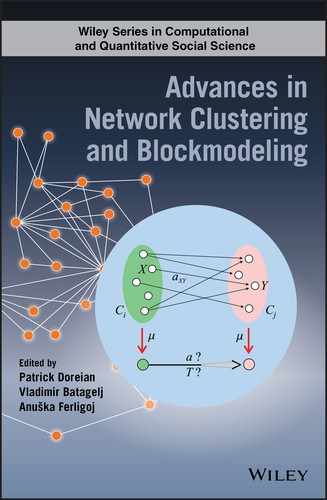Book Description
Provides an overview of the developments and advances in the field of network clustering and blockmodeling over the last 10 years
This book offers an integrated treatment of network clustering and blockmodeling, covering all of the newest approaches and methods that have been developed over the last decade. Presented in a comprehensive manner, it offers the foundations for understanding network structures and processes, and features a wide variety of new techniques addressing issues that occur during the partitioning of networks across multiple disciplines such as community detection, blockmodeling of valued networks, role assignment, and stochastic blockmodeling.
Written by a team of international experts in the field, Advances in Network Clustering and Blockmodeling offers a plethora of diverse perspectives covering topics such as: bibliometric analyses of the network clustering literature; clustering approaches to networks; label propagation for clustering; and treating missing network data before partitioning. It also examines the partitioning of signed networks, multimode networks, and linked networks. A chapter on structured networks and coarsegrained descriptions is presented, along with another on scientific coauthorship networks. The book finishes with a section covering conclusions and directions for future work. In addition, the editors provide numerous tables, figures, case studies, examples, datasets, and more.
- Offers a clear and insightful look at the state of the art in network clustering and blockmodeling
- Provides an excellent mix of mathematical rigor and practical application in a comprehensive manner
- Presents a suite of new methods, procedures, algorithms for partitioning networks, as well as new techniques for visualizing matrix arrays
- Features numerous examples throughout, enabling readers to gain a better understanding of research methods and to conduct their own research effectively
- Written by leading contributors in the field of spatial networks analysis
Advances in Network Clustering and Blockmodeling is an ideal book for graduate and undergraduate students taking courses on network analysis or working with networks using real data. It will also benefit researchers and practitioners interested in network analysis.
Table of Contents
- Cover
- List of Contributors
- 1 Introduction
- 2 Bibliometric Analyses of the Network Clustering Literature
- 3 Clustering Approaches to Networks
- 4 Different Approaches to Community Detection
- 4.1 Introduction
- 4.2 Minimizing Constraint Violations: the Cut-based Perspective
- 4.3 Maximizing Internal Density: the Clustering Perspective
- 4.4 Identifying Structural Equivalence: the Stochastic Block Model Perspective
- 4.5 Identifying Coarse-grained Descriptions: the Dynamical Perspective
- 4.6 Discussion
- 4.7 Conclusions
- Acknowledgements
- References
- Note
- 5 Label Propagation for Clustering
- 6 Blockmodeling of Valued Networks
- 7 Treating Missing Network Data Before Partitioning
- 8 Partitioning Signed Networks
- 9 Partitioning Multimode Networks
- 10 Blockmodeling Linked Networks
- 11 Bayesian Stochastic Blockmodeling
- 11.1 Introduction
- 11.2 Structure Versus Randomness in Networks
- 11.3 The Stochastic Blockmodel
- 11.4 Bayesian Inference: The Posterior Probability of Partitions
- 11.5 Microcanonical Models and the Minimum Description Length Principle
- 11.6 The “Resolution Limit” Underfitting Problem and the Nested SBM
- 11.7 Model Variations
- 11.8 Efficient Inference Using Markov Chain Monte Carlo
- 11.9 To Sample or To Optimize?
- 11.10 Generalization and Prediction
- 11.11 Fundamental Limits of Inference: The Detectability–Indetectability Phase Transition
- 11.12 Conclusion
- References
- Notes
- 12 Structured Networks and Coarse-Grained Descriptions: A Dynamical Perspective
- 13 Scientific Co-Authorship Networks
- 14 Conclusions and Directions for Future Work
- TOPIC INDEX
- PERSON INDEX
- End User License Agreement
